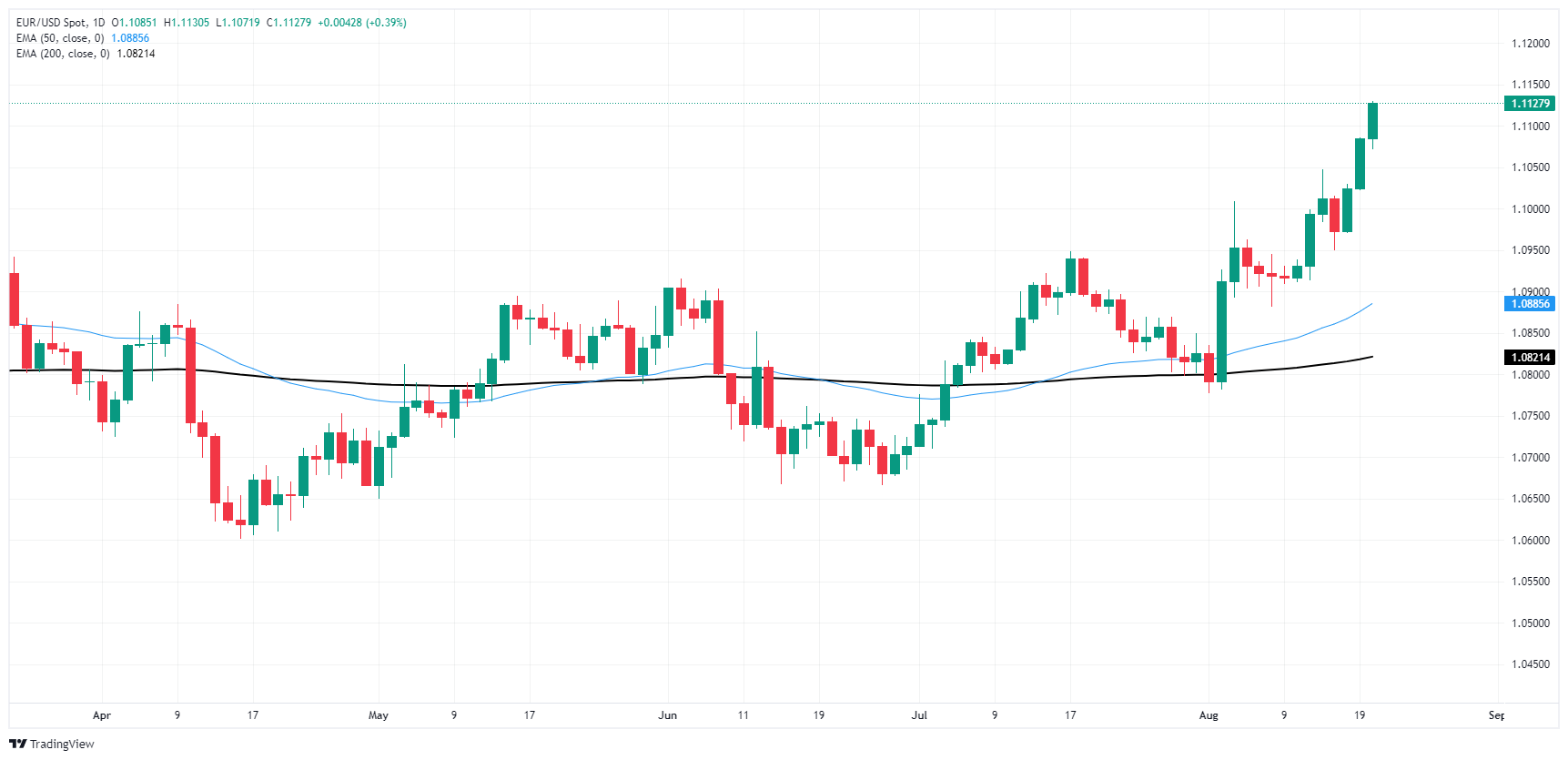EUR/USD up almost a full percent this week ahead of Jackson Hole

- EUR/USD climbed four-tenths of one percent on Tuesday.
- Markets are broadly pivoting into a risk-on stance, pressuring the US Dollar.
- Investors will be craning their necks for signs of Fed rate cuts.
EUR/USD drove up 0.4% on Tuesday, breaching back above 1.1100 for the first time since last December, chalking in a fresh high for 2024. The pair has closed firmly in the green for three straight trading days, and is on pace to climb a full percent since Monday’s opening bids.
Pan-European Purchasing Managers Index (PMI) activity survey results are expected early Thursday, with the EU Manufacturing and Services PMIs for August both expected to hold steady, at 45.8 and 51.9, respectively.
US Purchasing Manager Index (PMI) business activity survey results are slated for release on Thursday, as well as the kickoff of the annual Jackson Hole Symposium which is set to run through the weekend. Wednesday will deliver the Federal Reserve’s (Fed) latest Meeting Minutes, but market forces will broadly be looking ahead to Thursday’s outings for reasons to move.
US S&P Global Manufacturing PMI activity expectations are forecast to hold steady at 49.6 in August, while the Services PMI component is expected to tick down a full point to 54.0 from 55.0. The kickoff of the Jackson Hole Symposium is expected to draw plenty of investor attention on Thursday, but Friday’s appearance from Fed Chairman Jerome Powell can be expected to set the overall tone of market sentiment heading into next week.
EUR/USD price forecast
Fiber pushed into a fresh peak for the 2024 calendar year, tipping over 1.3050 as markets sell the Greenback short across the board, rather than for any particular reason to bid up the Euro. EUR/USD has closed in the green for all but one of the last seven straight trading days, and the pair is fully buried deep in bull country above the 200-day Exponential Moving Average (EMA) at 1.0835.
Despite the Fiber’s impressive recent run, a long-term consolidation range weighs heavily on technical charts, and a sharp upside swing could easily mean bidding momentum reverses course and sends price action back into familiar territory below 1.1000.
EUR/USD daily chart
Euro FAQs
The Euro is the currency for the 20 European Union countries that belong to the Eurozone. It is the second most heavily traded currency in the world behind the US Dollar. In 2022, it accounted for 31% of all foreign exchange transactions, with an average daily turnover of over $2.2 trillion a day. EUR/USD is the most heavily traded currency pair in the world, accounting for an estimated 30% off all transactions, followed by EUR/JPY (4%), EUR/GBP (3%) and EUR/AUD (2%).
The European Central Bank (ECB) in Frankfurt, Germany, is the reserve bank for the Eurozone. The ECB sets interest rates and manages monetary policy. The ECB’s primary mandate is to maintain price stability, which means either controlling inflation or stimulating growth. Its primary tool is the raising or lowering of interest rates. Relatively high interest rates – or the expectation of higher rates – will usually benefit the Euro and vice versa. The ECB Governing Council makes monetary policy decisions at meetings held eight times a year. Decisions are made by heads of the Eurozone national banks and six permanent members, including the President of the ECB, Christine Lagarde.
Eurozone inflation data, measured by the Harmonized Index of Consumer Prices (HICP), is an important econometric for the Euro. If inflation rises more than expected, especially if above the ECB’s 2% target, it obliges the ECB to raise interest rates to bring it back under control. Relatively high interest rates compared to its counterparts will usually benefit the Euro, as it makes the region more attractive as a place for global investors to park their money.
Data releases gauge the health of the economy and can impact on the Euro. Indicators such as GDP, Manufacturing and Services PMIs, employment, and consumer sentiment surveys can all influence the direction of the single currency. A strong economy is good for the Euro. Not only does it attract more foreign investment but it may encourage the ECB to put up interest rates, which will directly strengthen the Euro. Otherwise, if economic data is weak, the Euro is likely to fall. Economic data for the four largest economies in the euro area (Germany, France, Italy and Spain) are especially significant, as they account for 75% of the Eurozone’s economy.
Another significant data release for the Euro is the Trade Balance. This indicator measures the difference between what a country earns from its exports and what it spends on imports over a given period. If a country produces highly sought after exports then its currency will gain in value purely from the extra demand created from foreign buyers seeking to purchase these goods. Therefore, a positive net Trade Balance strengthens a currency and vice versa for a negative balance.
